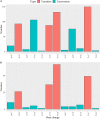Mitochondrial DNA Mutation Analysis in Breast Cancer: Shifting From Germline Heteroplasmy Toward Homoplasmy in Tumors
- PMID: 33194675
- PMCID: PMC7653098
- DOI: 10.3389/fonc.2020.572954
Mitochondrial DNA Mutation Analysis in Breast Cancer: Shifting From Germline Heteroplasmy Toward Homoplasmy in Tumors
Abstract
Studies have suggested a potential role of somatic mitochondrial mutations in cancer development. To analyze the landscape of somatic mitochondrial mutation in breast cancer and to determine whether mitochondrial DNA (mtDNA) mutational burden is correlated with overall survival (OS), we sequenced whole mtDNA from 92 matched-paired primary breast tumors and peripheral blood. A total of 324 germline variants and 173 somatic mutations were found in the tumors. The most common germline allele was 663G (12S), showing lower heteroplasmy levels in peripheral blood lymphocytes than in their matched tumors, even reaching homoplasmic status in several cases. The heteroplasmy load was higher in tumors than in their paired normal tissues. Somatic mtDNA mutations were found in 73.9% of breast tumors; 59% of these mutations were located in the coding region (66.7% non-synonymous and 33.3% synonymous). Although the CO1 gene presented the highest number of mutations, tRNA genes (T,C, and W), rRNA 12S, and CO1 and ATP6 exhibited the highest mutation rates. No specific mtDNA mutational profile was associated with molecular subtypes of breast cancer, and we found no correlation between mtDNA mutational burden and OS. Future investigations will provide insight into the molecular mechanisms through which mtDNA mutations and heteroplasmy shifting contribute to breast cancer development.
Keywords: breast cancer; haplogroups; heteroplasmy; mitochondrial DNA; molecular subtypes; mutations.
Copyright © 2020 Pérez-Amado, Tovar, Gómez-Romero, Beltrán-Anaya, Bautista-Piña, Dominguez-Reyes, Villegas-Carlos, Tenorio-Torres, Alfaro-Ruíz, Hidalgo-Miranda and Jiménez-Morales.
Figures



Similar articles
-
Mutational patterns in the breast cancer mitochondrial genome, with clinical correlates.Carcinogenesis. 2014 May;35(5):1046-54. doi: 10.1093/carcin/bgu012. Epub 2014 Jan 18. Carcinogenesis. 2014. PMID: 24442641 Free PMC article.
-
Somatic mutations of the mitochondrial genome in human breast cancers.Genes Chromosomes Cancer. 2011 Oct;50(10):800-11. doi: 10.1002/gcc.20901. Epub 2011 Jul 11. Genes Chromosomes Cancer. 2011. PMID: 21748819
-
Identification of Somatic Mitochondrial DNA Mutations, Heteroplasmy, and Increased Levels of Catenanes in Tumor Specimens Obtained from Three Endometrial Cancer Patients.Life (Basel). 2022 Apr 9;12(4):562. doi: 10.3390/life12040562. Life (Basel). 2022. PMID: 35455053 Free PMC article.
-
Mitochondrial Mutations in Cardiac Disorders.Adv Exp Med Biol. 2017;982:81-111. doi: 10.1007/978-3-319-55330-6_5. Adv Exp Med Biol. 2017. PMID: 28551783 Review.
-
Mitochondrial DNA mutations and breast tumorigenesis.Biochim Biophys Acta. 2013 Dec;1836(2):336-44. doi: 10.1016/j.bbcan.2013.10.002. Epub 2013 Oct 16. Biochim Biophys Acta. 2013. PMID: 24140413 Free PMC article. Review.
Cited by
-
Intercellular transfer of mitochondrial DNA carrying metastasis-enhancing pathogenic mutations from high- to low-metastatic tumor cells and stromal cells via extracellular vesicles.BMC Mol Cell Biol. 2021 Oct 7;22(1):52. doi: 10.1186/s12860-021-00391-5. BMC Mol Cell Biol. 2021. PMID: 34615464 Free PMC article.
-
Unraveling the genetic connections for mitochondrial DNA control region and breast cancer susceptibility.Sci Rep. 2025 Feb 9;15(1):4821. doi: 10.1038/s41598-025-89115-9. Sci Rep. 2025. PMID: 39924515 Free PMC article.
-
Precise Identification of Recurrent Somatic Mutations in Oral Cancer Through Whole-Exome Sequencing Using Multiple Mutation Calling Pipelines.Front Oncol. 2021 Nov 29;11:741626. doi: 10.3389/fonc.2021.741626. eCollection 2021. Front Oncol. 2021. PMID: 34912705 Free PMC article.
-
Roles of mitochondrial genetics in cancer metastasis.Trends Cancer. 2022 Dec;8(12):1002-1018. doi: 10.1016/j.trecan.2022.07.004. Epub 2022 Jul 29. Trends Cancer. 2022. PMID: 35915015 Free PMC article. Review.
-
The movement of mitochondria in breast cancer: internal motility and intercellular transfer of mitochondria.Clin Exp Metastasis. 2024 Oct;41(5):567-587. doi: 10.1007/s10585-024-10269-3. Epub 2024 Mar 15. Clin Exp Metastasis. 2024. PMID: 38489056 Free PMC article. Review.
References
LinkOut - more resources
Full Text Sources

